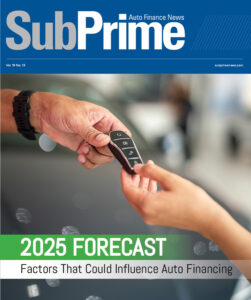S&P pinpoints 2 main risk areas in auto finance

Photo from Shutterstock.com
S&P Global Ratings recently considered what two specific areas contain the most risk since loosening underwriting resulted in U.S. auto loans and leases rising steadily over the past several years to reach all-time highs in 2016.
With more than $1 trillion in outstanding balances, S&P Global Ratings acknowledged the figure has raised questions about whether the growth will ultimately lead to significant asset quality deterioration and increased depreciation on leases, as well as which finance companies will bear the impact. The firm considered those questions and more in recent article titled, “How Worsening Auto Finance Conditions Could Affect Banks, Nonbank Finance Companies, and Captive Finance Companies.”
Adding to analysts’ concerns are subprime auto delinquencies climbing recently while used-vehicle prices have somewhat declined.
“We believe the greatest areas of market and credit risks are leasing and nonprime —including subprime —lending, respectively, and the financial institutions with significant concentrations in those areas, or in auto finance in general, are at risk of declining earnings or even bottom-line losses,” said S&P Global Ratings credit analyst Brendan Browne.
S&P Global Ratings reminded the industry that the financial institutions the firm rates includes captive auto finance companies owned by manufacturers given that they hold the lion's share of leases. Because of their contract exposure, the firm also mentioned that its recent analysis includes two nonbank auto finance companies — DriveTime Automotive Group and Credit Acceptance — as well as a handful of banks, most notably Santander Holdings USA and Ally Financial.
"If used-car prices continue to fall, the captives likely will have to report higher depreciation expenses on their leases, and non-prime lenders will have lower recoveries on defaulted loans,” Browne said. “A further increase in delinquencies and losses on loans would affect lenders. We could lower our ratings on companies in auto finance if these trends were severe enough.”
With regard to the used-vehicle prices, the Manheim Used Vehicle Value Index came in at 124.7 in April, which was up 1.6 percent year-over-year. According to a report accompanying the index, wholesale prices climbed 0.5 percent from March on a mix-, mileage- and seasonally adjusted basis.
In an analysis accompanying the index, Cox Automotive chief economist Tom Webb downplayed the concern many analysts have expressed about used-car price declines.
“Although the Manheim Used Vehicle Value Index increased for the first time this year on a month-over-month basis, used-vehicle values have not collapsed the way many analysts have warned of for more than a year due to expected increases in wholesale supplies,” Webb said. “And in fact, what weakness we have seen is probably more a result of excessive new-vehicle inventory, not used.”
Meanwhile, TransUnion reported the auto finance delinquency rate increased from 1.16 percent in Q1 2016 to 1.30 percent in Q1 2017, driven by poorer payment performance in the subprime and near prime segments.
“Serious auto loan delinquency rates are approaching levels not seen since the recession, but it’s important to understand that delinquencies in the auto market never elevated to levels observed for other key credit products such as credit cards and mortgages,” said Brian Landau, senior vice president for financial services and automotive business leader for TransUnion.
“Regardless, with flatter sales volumes and higher delinquencies, we anticipate lenders will evaluate their credit policies for subprime and near prime borrowers to calibrate for the uptick in delinquencies,” Landau continued.
S&P Global Ratings indicated a few factors that provide some protection against ratings downgrades include support from parents (as in the case of the captives and Santander), diversification outside of auto (for most banks), and ratings that already factor in an expectation of high losses on auto loans (as in the case of the nonbank finance companies).
“Still, we view worsening conditions in auto finance as a negative rating factor for all of these companies,” S&P Global Ratings said.
The S&P Global Ratings report is available to subscribers of RatingsDirect at www.globalcreditportal.com and at www.spcapitaliq.com.
Staff writer Joe Overby contributed to this report.

 View The Latest Edition
View The Latest Edition

